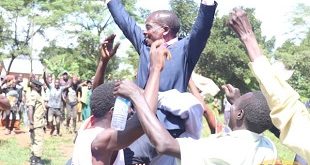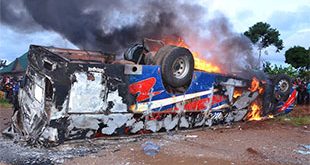
Kampala, Uganda | THE INDEPENDENT | Government toxicologist Dr. Jaffer Kisitu on Thursday told the court, presided over by High Court Judge Justice Comfort Kania, that there is a minimum criterion for confirming the presence of gunshot residue (GSR), and if a sample does not meet that criterion, it will not be reported as GSR.
Dr. Kisitu was clarifying his testimony in the high-profile Katanga murder trial, where he appeared as the 12th prosecution witness.
In earlier testimony, Kisitu had been asked to explain the chemical elements found in gunshot residue, which he did in detail. He later admitted that GSR was not detected on cotton swabs taken from Molly Katanga’s right hand, which had been submitted to his laboratory for analysis on November 10, 2023.
Kisitu confirmed that no GSR was found on Molly Katanga’s right hand, with the swabs labeled M2 and M3.
However, during re-examination, Kisitu noted that while no residue was found on Molly’s right hand, a chemical compound consistent with GSR was detected on her left hand.
When pressed further by defense lawyers led by Elison Karuhanga regarding the interpretation of the results, Kisitu responded that he was not required to provide an interpretation of the report – prompting concern from Judge Kania, who questioned the purpose of the report if no interpretation could be offered.
“The minimum criterion (consistency and characteristic) is that you must have two compounds. M1 has one Category 1 compound and no second Category 1 compound, hence does not meet the minimum criterion for gunshot residue as a standalone sample. Correct?” Karuhanga asked Dr. Kisitu, who replied in the affirmative. He added that if fewer than the required compounds are identified, the results must be listed but reported as inconclusive.
Karuhanga then argued that the samples in M3 also failed to meet the criterion outlined in paragraph 10:3:1 of the report and therefore could have sources other than gunshot residue. He insisted that a negative result should have been recorded, as was done with the M2 samples.
#UgandaVsMollyKatanga
This matter returns to the High Court tomorrow for further hearing.The State will be bringing a new witness, PW13.
We are now 12 witnesses in and we shall be bringing you a summary in a few days.
But back to Dr Jaffer Kisitu, the last man on the witness… https://t.co/GpH5VS5QEP pic.twitter.com/EJwWFWz16C
— Anthony Natif (@TonyNatif) April 21, 2025
On the key issue of whether the sample that did indicate the presence of GSR could offer deeper insights, Dr. Kisitu confirmed that the available data could not determine which hand fired the weapon. He also affirmed that GSR can be acquired simply by being in an environment where a firearm has been discharged.
“Gunshot residue cannot be used to infer whether the person fired the firearm, but it can be used to associate the person with the firearm or deduce that they were in contact with or in the vicinity where a firearm was discharged,” he concluded.
Dr. Kisitu’s testimony aligns with that of the 11th prosecution witness, Derrick Nassawali, a ballistics expert, who admitted that he could not rule out suicide as the cause of death in the Katanga case.
Nassawali noted that the accused, Molly Katanga, had sustained broken index fingers and fractures in both arms at the time of the shooting. When asked whether it was plausible that someone with such injuries could aim and fire a gun, he responded that while it might be possible for a well-trained individual, it remained highly doubtful.
Court proceedings are scheduled to resume on Tuesday.
 The Independent Uganda: You get the Truth we Pay the Price
The Independent Uganda: You get the Truth we Pay the Price



